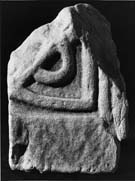Select a site alphabetically from the choices shown in the box below. Alternatively, browse sculptural examples using the Forward/Back buttons.
Chapters for this volume, along with copies of original in-text images, are available here.
Object type: Fragment of cross-shaft or -head
Measurements: H. 23.5 cm (9.25 in); W. 19 cm (7.5 in) D. 15.2 cm (6 in)
Stone type: Coarse-grained, massive yellow sandstone
Plate numbers in printed volume: Pl. 161.849-852
Corpus volume reference: Vol 1 p. 169-170
(There may be more views or larger images available for this item. Click on the thumbnail image to view.)
Dowel-holes indicate that this is the top of a shaft or part of a cross-head. Only part of two faces surviving.
A? (broad): This has a wide flat-band moulding at the bottom and an outer flat-band and inner roll moulding on the right edge. Inside is part of an interlace element with rounded strands but punch-outlined.
B? (narrow): The edge moulding survives only on the left, but the arrangement seems to have been as for face A. Part of a similar interlace element has survived.
C? (broad) and D? (narrow): Hacked or broken away.
The group of crosses from Carham is a reflection of the importance of the Border area in the late tenth to early eleventh century. A battle was fought there in 1018 and Symeon's account implies that Carham was one of the properties of the Chester-le-Street/Durham community (Symeon 1882a, 84). These sculptures are linked with the Durham school of sculpture (Introduction, pp. 32-3).



